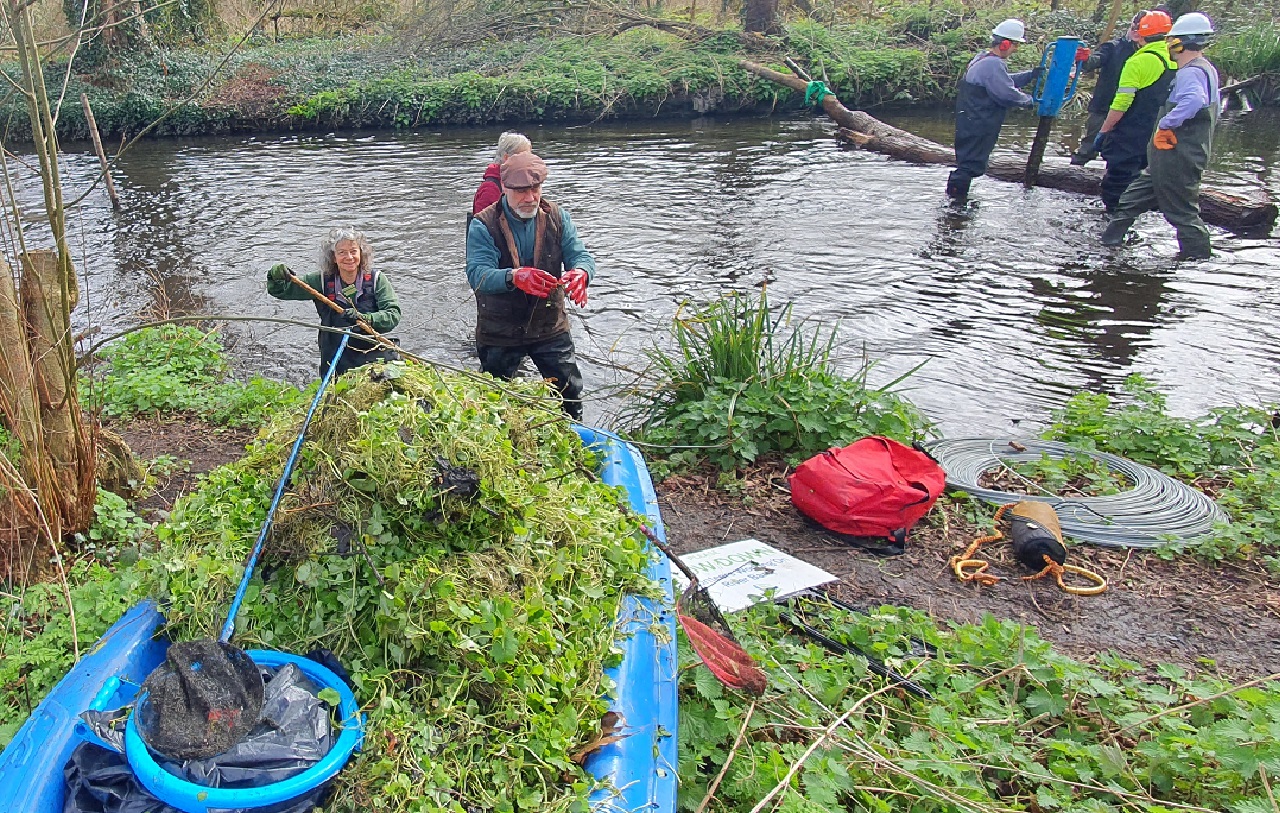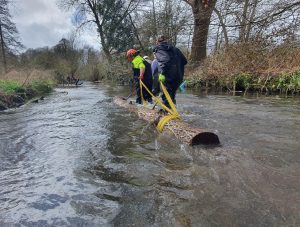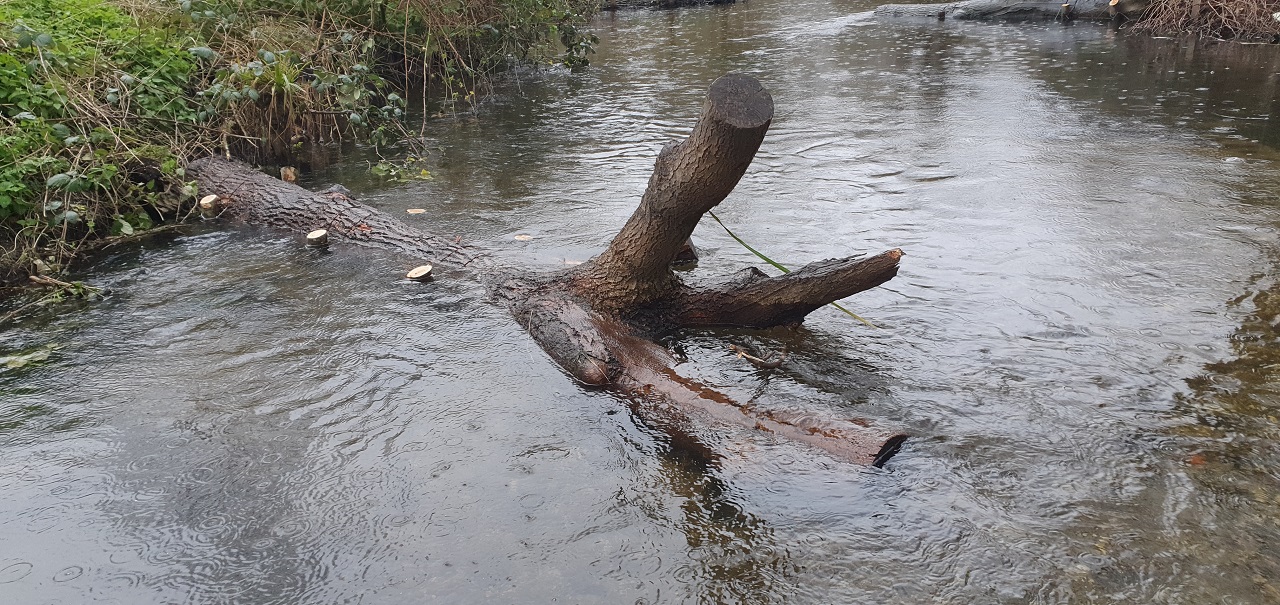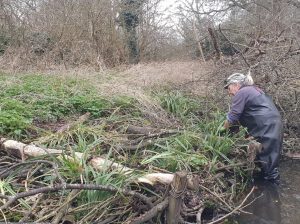Dozens of volunteers made a huge difference to the River Wandle during Wandle Fortnight (11th-24th September), carrying out restoration or learning to record invasive species across the catchment.
Firstly, about 40 volunteers in total worked across five days at Morden Hall Park, continuing our on-going work along this section of the Wandle at the National Trust site.
In a separate event, we also trained more than 20 people how to spot invasive non-native species (INNS) so they could go out during the Fortnight and record their presence using an App, to inform our catchment work.
These two events were intrinsically linked: when we take volunteers to continue our Morden Hall Park work twice a year in autumn and spring, the first task is to remove floating pennywort. This invasive plant is regularly seen across other parts of the Wandle and was one of the top types of INNS our volunteers were trained to record.
We also took the opportunity of Wandle Fortnight to schedule an event to talk to residents about a weir lowering project.
The problems with pennywort
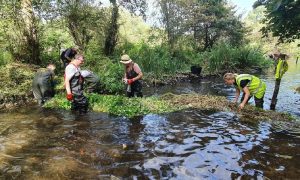
Like many invasive species, the pennywort might look colourful, but this fast-growing plant crowds out native plants, takes oxygen from fish and insects and cuts out light, inhibiting aquatic wildlife. At Morden Hall, the removed pennywort is composted by the National Trust. It can form a big mat, meaning volunteers drag this a short distance to a boat or suitable exit place for it to be lifted out of the water.
If pennywort is left to decay in the river, the bottom of slow moving sections as useful river channel for wildlife, depleting oxygen levels as it breaks down. This further serves to prevent many invertebrates and other species from completing their life cycles, reducing biodiversity.
Once we removed the pennywort, volunteers then turned their efforts to installing four more deflectors – large pieces of wood – and creating three more berms along the banks at Morden Hall, completing the current round of work, funded by the Environment Agency, we have been doing there since 2020.
Watch volunteers work on a berm
Manoeuvring the deflectors and putting stakes in to keep them in place is tough physical work, but the benefits are huge as we change a once-straight river into a meandering channel where the flow is much more varied. These large tree chunks, cut down as part of woodlands management by the National Trust, help to clean gravels and create pools behind them, providing areas where fish can spawn and thrive.
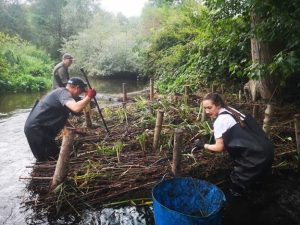
The berms, which are built as an extension of the sides of the river, are made of brash. Volunteers planted them with sedge species that work best in shady areas. These plants were mostly relocated from the wetlands and help to filter out pollutants and excess nutrients while providing habitats for invertebrates. Golden flag iris was one plant inserted into these berms. Volunteers, many of whom have returned after previous sessions, could see the vegetation from previous efforts providing nourishment for nature.
Project officer Harry Clarke said: “The twice-yearly efforts by volunteers at Morden Hall Park are really starting to bear fruit and be visible. Now we can see moor hens, herons and ducks regularly making the most of the benefits of a narrower river channel and much more vegetation along the banks.”
The flow of the river now has a much more meandering course as a result of our work over the past few years – and our video shows the results.
Training volunteers to help us map invasive plants
Our INNS training session at Sutton Ecology Centre was attended by 22 people, who learned about various plant species that do harm to our rivers. Newly educated, they were empowered to carry out surveys on walks alongside rivers, starting in Wandle Fortnight. They have until the end of October to record them on an . The data these citizen scientists collect will help us – as catchment partnership hosts for the Wandle – form plans to tackle INNS on the entire river network in the future.
While floating pennywort, Giant Hogsweed and Himalayan Balsam might be best known and the most common invasive fauna on our rivers, volunteers were also trained to look out for Japanese knotweed, parrots feather, New Zealand pygmy weed and giant rhubarb.
Japanese knotweed, introduced to the UK in the mid-1800s, is known to be along the river at Poulter’s Park. Emerging in March, it can grow at 5-10cm a day and easily displace native vegetation. Dying back in winter, it leaves bare soil which, if washed out, can spread downstream. Where large stands of the plant persist on river banks there is an increased sediment input into the river. In slow moving waters this silt will accumulate and smother the riverbed, rendering the habitat unsuitable for fish spawning.
We asked volunteers to survey for giant rhubarb (gunnera tinctoria) for the first time, because it has been found in other parts of the UK. Giant rhubarb is an ornamental plant originally found in Chile and Argentina which thrives in streams or roadsides, liking damp conditions.
This plant’s wide leaf span and large dense stands can have a dramatic impact on the local biodiversity by excluding light. On rivers it causes erosion to banks, exposing them to fast running water after die-back in winter. Identified as a non-native invasive species, it is illegal to knowingly allow it to spread outside a property.
Parrots feather’s rapid growth means it quickly outcompetes native vegetation, forming mats and blocking sunlight and depleting oxygen levels for river wildlife. Left to spread in the wild we’re likely to see an increasing area of land lost to grazing as well as significant impacts on our biodiversity and road-side drains.
Similarly, New Zealand pigmy weed likes garden ponds. It also harms the growth of native vegetation in rivers forming a dense mat and reducing food, shelter and refuge for aquatic species.
Rachael Edwards, Volunteer Officer for SERT, said: “The efforts of volunteers as they walk along riverbanks looking for these species will really have a big impact on the action plan we, as hosts of the Wandle catchment partnership, can put together to tackle INNS for many years to come. We will then be able to focus our efforts on problem areas and know where, for example, to focus our efforts for our popular ‘balsam bashes’.”
Explaining the Goat Bridge weir project
One of our last events in Wandle Fortnight was to talk to residents about a project to lower the weir at Goat Bridge and make changes to the river channel, improving a section at Mitcham for wildlife.
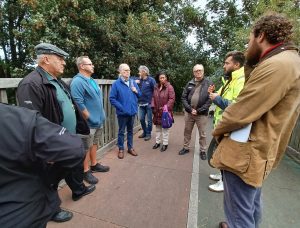
Nearly 30 people attended our community event where partners from Thames Water, the London Borough of Sutton, the Environment Agency and engineering consultancy Mott MacDonald explained the project at a nearby community centre and by conducting tours of the area.
The key reason for lowering the weir and installing rock ramps and bed check weirs is to make this part of the Wandle passable for fish. At present it is totally impassible.
Currently, the weir leaves about a 500m section of the River Wande with conditions akin to a lake, as opposed to a flowing river.
Work on the project is scheduled to begin later this autumn.
Full details about the project and its benefits to the river can be found on our dedicated web page.
Our video shows how the weir at Goat Bridge creates a barrier to fish passage.


